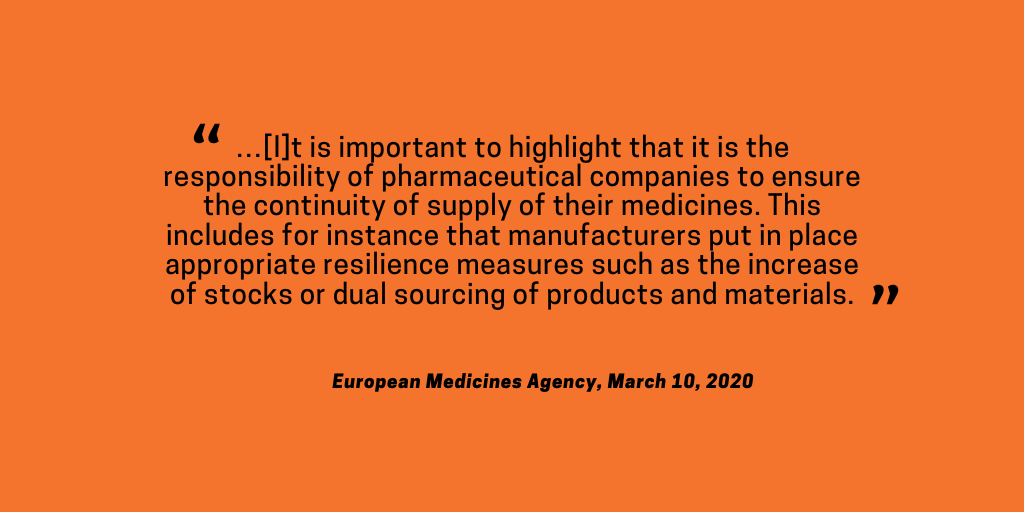EU Moves To Mitigate Potential Disruptions in Drug Supply
The European Medicines Agency, the European Commission, and EU national regulatory authorities have formed an EU Executive Steering Group to address potential supply disruptions in medicines stemming from the novel coronavirus outbreak. What does the new group plan to do?
Evaluating impact on medicines supply
The European Medicines Agency (EMA) issued an update this week (March 10, 2020) to report that it and its partners in the European medicines regulatory network are closely monitoring the potential impact of the outbreak of the novel coronavirus disease (COVID-19) on pharmaceutical supply chains into the European Union (EU). The EMA says that there have been no reports received (as of March 10, 2020) of current shortages or supply disruptions of medicines marketed in the EU due to the COVID-19 outbreak.
The EMA notes, however, that “as the public health emergency develops, shortages or disruptions cannot be excluded,” said the agency in a March 10, 2020 statement. To address that possibility, the EMA, the European Commission and national competent authorities in EU member states have organized the first meeting of the EU Executive Steering Group on Shortages of Medicines Caused by Major Events to discuss measures aimed at addressing the impact of the outbreak of COVID-19 on the supply of medicines in the EU.
The mandate of this group, says the EMA, is to provide strategic leadership for urgent and coordinated action within the EU in case a crisis caused by major events, such as the COVID-19 outbreak, poses risks impacting the supply of medicinal products for human and veterinary use.

In the context of COVID-19, the group will identify and coordinate EU-wide actions when medicines in the EU are at risk of supply shortage, e.g. due to a temporary lockdown of manufacturing sites in areas affected by COVID-19 or travel restrictions impacting shipment. “The group will also ensure that patients and healthcare professionals across the EU are kept informed in a consistent and transparent manner about the risks and the remedial actions taken,” said the EMA in its March 10, 2020 statement.
The steering group is chaired by the European Commission. Its membership is made up of representatives from the European Commission, the Heads of Medicines Agencies (HMA), the EMA, the chairs of the Coordination Groups for Mutual-Recognition and Decentralized Procedures for both human and veterinary medicines (CMDh and CMDv) as well as risk-communication specialists.
“While the purpose of the group is to address disruptions of the supply of medicines in the EU through a coordinated approach, it is important to highlight that it is the responsibility of pharmaceutical companies to ensure the continuity of supply of their medicines,” said the EMA in its March 10, 2020 statement. “This includes for instance that manufacturers put in place appropriate resilience measures such as the increase of stocks or dual sourcing of products and materials.”
Actions already taken
The EMA further outlined what EU authorities are already doing to monitor the potential impact of the COVID-19 outbreak on medicines as outlined below.
Information sharing via a Single Point of Contact. First, the EMA and national pharmaceutical regulatory authorities are sharing information on shortages via the Single Point of Contact (SPOC). Since April 2019, the HMA/EMA Task Force on the Availability of Authorized Medicines for Human and Veterinary Use has been running a pilot program on establishing a SPOC network to improve information sharing between EU member states, the EMA, and the European Commission on important medicine shortages of human and veterinary medicines and to coordinate actions to help prevent and manage shortages. This includes information sharing on alternative medicines that are available in other EU member states. The HMA/EMA task force was formed in 2016 to provide strategic support and advice to address disruptions in supply of human and veterinary medicines and ensure their continued availability.
The first phase of the pilot ran from April 2019 to August 2019 to test the functioning and usefulness of the information exchange via the SPOCs. During this phase, 24 EU member states used the SPOC system and circulated 52 notifications of shortages. The task force had earlier planned to run a second phase of the pilot in 2020 to test the criteria for identifying cases deserving EU-wide coordinated action and for network alerts of upcoming public communications that could have a high impact on patients.
Raising industry awareness. The EMA requested EU pharmaceutical industry associations to raise awareness among their members of the potential impact of quarantine measures in China and elsewhere on the supply of medicines in the European Economic Area (EEA), both for human and veterinary use, and to remind their members of their obligation to report any possible shortages to EU authorities. The The EEA consists of EU member states, Iceland, Liechtenstein, and Norway.
Assessment of preparedness. The EMA also asked pharmaceutical industry associations to assess the preparedness of their members to prevent possible shortages that may result from the coronavirus outbreak and report back to the EMA, and for specific products, to the relevant competent authorities. The EMA says that industry associations have indicated that no specific disruptions have yet been identified and that any impact in the short-term would be limited, given the current stocks in place. However, the EMA notes that supply issues can be expected if lockdowns continue and/or other supply disruptions occur, which are caused by logistical problems or export restrictions.
Information, including manufacturing information, required of marketing authorization holders. National medicines regulators are requesting information from marketing authorization holders and/or manufacturers in their EU member states. Industry associations at the national and EU-level will be asked to provide further information on the resilience of companies’ supply chains to regulators, which will be monitored through the steering group.
The EMA has also started to review all manufacturing information for centrally authorized human and veterinary medicines to identify those most at risk of shortages and disruptions and prioritize them for discussions about remedial actions with the marketing authorization holder. The EMA says that the CMDh and CMDv will be coordinating actions for nationally authorized medicines, and the EMA says it is working closely with them.








